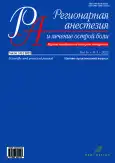Efficacy of regional anesthesia in episcleral surgery: a randomized controlled double-blind clinical study
- Authors: Oleshchenko I.G.1,2, Mankov A.V.2, Belyaev S.S.1
-
Affiliations:
- Irkutsk branch of S.N. Fyodorov «Eye microsurgery» Federal State Institution
- Irkutsk State Medical University
- Issue: Vol 16, No 3 (2022)
- Pages: 231-239
- Section: Original articles
- URL: https://journals.rcsi.science/1993-6508/article/view/232472
- DOI: https://doi.org/10.17816/RA110934
- ID: 232472
Cite item
Abstract
BACKGROUND: Surgical interventions for severe fundus diseases associated with diabetes mellitus, proliferative processes against the background of retinal detachment, and acute inflammatory diseases require the development of multimodal algorithms to provide sufficient analgesic and anti-inflammatory effects.
AIM: To evaluate the efficacy of combined pterygopalatine blockade (PPB) and retrobulbar blockade (RBB) in patients with episcleral retinal detachment surgery.
MATERIALS AND METHODS: The study included 100 patients who underwent episcleral surgery for retinal detachment. All patients were randomized into two groups: group 1 (retrobulbar blockade, n=50) and group 2 (pterygopalatine blockade in combination with retrobulbar blockade, n=50). The level of akinesia, volume of local anesthetic, consumption of analgesics, pain, and postoperative nausea and vomiting (PONV) were evaluated.
RESULTS: In group 2, only 12% of the patients were prescribed promedol 2% intraoperatively, which is significantly lower than that in group 1 (p=0.463). In group 2, the pain level 8 h after surgery according to the verbal sensation scale was 0.8±0.63. In group 1, the average pain score was 1.69±1.8 (p=0.558). PONV was observed in 4% of the patients in group 1. In group 2, no PONV occurred (p=0.563).
CONCLUSION: The combination of PPB and RBB allows for controlling not only pain sensitivity but also vegetative, motor, and neuroendocrine manifestations associated with pain both in the intraoperative and early postoperative periods.
Full Text
##article.viewOnOriginalSite##About the authors
Irina G. Oleshchenko
Irkutsk branch of S.N. Fyodorov «Eye microsurgery» Federal State Institution; Irkutsk State Medical University
Author for correspondence.
Email: iga.oleshenko@mail.ru
ORCID iD: 0000-0003-1642-5276
SPIN-code: 8824-1216
MD, Cand. Sci. (Med.)
Russian Federation, Irkutsk; IrkutskAleksandr V. Mankov
Irkutsk State Medical University
Email: man-aleksandrv@yandex.ru
ORCID iD: 0000-0001-8701-6432
SPIN-code: 7135-2828
MD, Cand. Sci. (Med.)
IrkutskSergey S. Belyaev
Irkutsk branch of S.N. Fyodorov «Eye microsurgery» Federal State Institution
Email: dr.beliaev2016@yandex.ru
ORCID iD: 0000-0002-0508-4333
anesthesiologist-resuscitator
Russian Federation, IrkutskReferences
- Xu YX, Liu LP, Li JB, et al. Vitreoretinal surgeons’ experience and time interval from pars-plana vitrectomy to cataract extraction. Int J Ophthalmol. 2021;14(1):120–126. doi: 10.18240/ijo.2021.01.17
- Costen MT, Newsom RS, Wainwright AC, et al. Expanding role of local anaesthesia in vitreoretinal surgery. Eye (Lond). 2005;19(7):755–761. doi: 10.1038/sj.eye.6701640
- Martin F, Martinez V, Mazoit JX, et al. Antiinflammatory effect of peripheral nerve blocks after knee surgery: clinical and biologic evaluation. Anesthesiology. 2008;109(3):484–90. doi: 10.1097/ALN.0b013e318182c2a1
- De Pinto M, Dagal A, O’Donnell B, et al. Regional anesthesia for management of acute pain in the intensive care unit. Int J Crit Illn Inj Sci. 2015;5(3):138–143. doi: 10.4103/2229-5151.164917
- Foad AZ., Mansour MA., Ahmed MB., et al. Real-time ultrasound-guided retrobulbar block vs blind technique for cataract surgery (pilot study). Local Reg Anesth. 2018;11:123–128. doi: 10.2147/LRA.S178771
- Mirza F, Brown AR. Ultrasound-guided regional anesthesia for procedures ofthe upper extremity. Anesthesiol Res Pract. 2011;2011:579824. doi: 10.1155/2011/579824
- Hausman MS, Jewell ES, Engoren M. Regional versus general anesthesia in surgical patients with chronic obstructive pulmonary disease: does avoiding general anesthesia reduce the risk of postoperative complications? Anesth Analg. 2015;120(6):1405–1412. doi: 10.1213/ANE.0000000000000574
- Fekrat S, Elsing SH, Raja SC, et al. Eye pain after vitreoretinal surgery: a prospective study of 185 patients. Retina. 2001;21(6):627–632. doi: 10.1097/00006982-200112000-00010
- Oleshchenko I, Cok OY, Iureva T, et al. Effect of pterygopalatine blockade on perioperative stress and inflammatory outcomes following paediatric cataract surgery. Reg Anesth Pain Med. 2020;45(3):204–208. doi: 10.1136/rapm-2019-100823
- Degirmenci N, Ozdem A, Uysal H, et al. The Effect of Sphenopalatine Ganglion Block on the Postoperative Pain in Patients Undergoing Septorhinoplasty. Ann Otol Rhinol Laryngol. 2020;129(7):722–726. doi: 10.1177/0003489420909417
- Parameswaran A, Ganeshmurthy MV, Ashok Y, et al. Does Sphenopalatine Ganglion Block Improve Pain Control and Intraoperative Hemodynamics in Children Undergoing Palatoplasty? A Randomized Controlled Trial. J Oral Maxillofac Surg. 2018;76(9):1873–1881. doi: 10.1016/j.joms.2018.03.037
- Piagkou M, Demesticha T, Troupis T, et al. The pterygopalatineganglion and its role in various pain syndromes: from anatomy to clinicalpractice. Pain Pract. 2012;12(5):399–412. doi: 10.1111/j.1533-2500.2011.00507.x
- Ebbeling MB, Oomen KP, de Ru JA, et al. Neurochemical characterization of pterygopalatine ganglion branches in humans. Am J Rhinol Allergy. 2012;26(1):e40–e45. doi: 10.2500/ajra.2012.26.3697
- Chan AW, Tetzlaff JM, Gøtzsche PC, et al. SPIRIT 2013 explanation and elaboration: guidance for protocols of clinical trials. BMJ. 2013;346:e7586. doi: 10.1136/bmj.e7586
- Bedi A, Carabine U. Peribulbar anaesthesia: a double-blindcomparison of three local anaesthetic solutions. Anaesthesia. 1999;54(1):67–71. doi: 10.1046/j.1365-2044.1999.00639.x
- Mahajan D, Sain S, Azad S, et al. Comparison of topical anesthesia and peribulbar anesthesia for 23-gauge vitrectomy with-out sedation. Retina. 2013;33(7):1400–1406. doi: 10.1097/IAE.0b013e31827ced51
- Marova NG, Vasiliev YaI, Klushnikova EV, et al. Local anesthesia for vitreo-retinal surgery. Regional Anesthesia and Acute Pain Management. 2018;12(1):24–29. (In Russ). doi: 10.18821/1993-6508-2018-12-1-24-29
- Robbins MS, Robertson CE, Kaplan E, et al. The Sphenopalatine Ganglion: Anatomy, Pathophysiology, and Therapeutic Targeting in Headache. Headache. 2016;56(2):240–258. doi: 10.1111/head.12729
- Solov’ev YeYa, Larionov SV, Zabusov AV, et al. The influence of the choice of anesthesia method during ankle osteosynthesis operations on the intensity of postoperative pain syndrome and the nature of local blood flow. Regional Anesthesia and Acute Pain Management. 2008;2(1): 28–32. (In Russ).
Supplementary files







